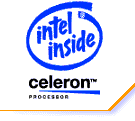


- Intel has
released a week ago its new version of the well known Celeron microprocessor.
We have all heard about the previous version of this chip which for me
( and for many others ) is one the most disappointing chip Intel
has released so far. The new Celeron chip has been well acknowledged by
many specialists and looks like a good release from Intel. So what is new
in this latest Celeron and what shall we expect from it?
Well, first of all we must tell that the new Celeron though sharing the same core as its old version ( Pentium II Deschuttes Core ) , behaves way better. Indeed as shown in Tom's hardware guide's benchmarks the new Celeron scores almost as much as its big brother ( Intel Pentium II ) at the same clock rates ( 300Mhz and 333Mhz ), which is pretty impressive if you compare the design of the 2 chips. What makes the difference between the old and the new Celeron ( named Mendocino ) is the addition of 128 KB of full speed on die Level 2 cache. This makes a big, big difference between the 2 models, indeed with no L2 cache at all the old Celeron was one of the slowest chip on today's market and this result is quite normal.
Explanation : Today's modern CPUs has at least 2 levels of cache ( that is not the case of the old Celeron which has only one level of cache ). The first level of cache ( L1 cache ) is always on die, runs at full CPU speed and contains several KB of data and instructions. For the new Celeron ( as well as for the other PII ) the L1 cache has a size of 32KB ( 16 KB for the data, 16 KB for the instructions ), this size allows the core to find roughly 80 percent of the instructions and data it needs to process. Since it is hard to integrate a big size of Level 1 cache on the chip, to improve the performances a second level of cache is usually added in most CPUs. This second level of cache ( Level 2 cache ) is the level that was not implemented in the former version of Celeron ( for cost reduction issues ) and was responsible for the very weak performances of this chip compared to all the other CPU on the x86 market. Indeed with no second level cache the core of the Celeron was compelled to access the slow main memory in most than 20 percents of the cases which is a disaster if you know how slow the main memories are today compared to the CPU cores ( 800 MB/s maximum throughput plus 50ns of access delay compared to the 3.3 ns of CPU cycle time of a PII 300 ).
Intel wants to target the Celeron at the low cost computer market, which is more or less the market targeted by AMD with its new ( and great ) AMD K6-3D chip. The AMD K6-3D has more or less the same performances as the Celeron at equivalent frequencies ( see Tom's hardware guide benchmarks ), so if Intel markets its new chip as low as AMD does, this could lead to a cool war on the low to middle range class computer market. Who will be the winner, I can't tell ( though I am pro AMD ) but it is going to be very, very tough!
| Related Links : |
|
Big CPU Shoot Out - Intel Launches new Celeron with Mendocino Core and Pentium II 450 : Tom's hardware guide coverage of the new Celeron launch. Celeron PCs are here: CNET's coverage of the new Celron launch. |
Question, comment or objection : email me.